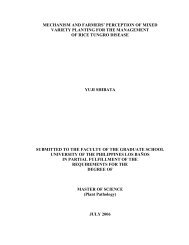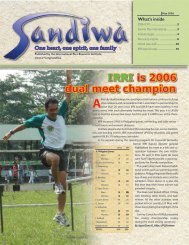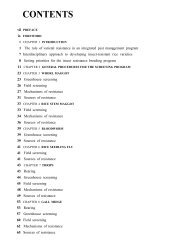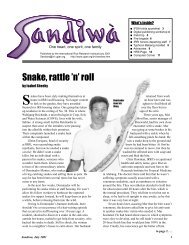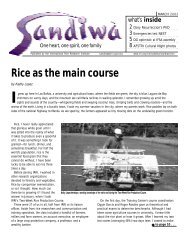Untitled - International Rice Research Institute
Untitled - International Rice Research Institute
Untitled - International Rice Research Institute
You also want an ePaper? Increase the reach of your titles
YUMPU automatically turns print PDFs into web optimized ePapers that Google loves.
Introduction<br />
The purpose of seed health testing is to assure the<br />
safe movement of seed of different crops, for research<br />
or trade. It is premised on the hypothesis that<br />
many harmful organisms are carried by and moved<br />
together with the seed, and that these organisms have<br />
the potential to cause severe damage to crop production<br />
and crop seed for international trade once they<br />
are introduced. Seed health testing information reveals<br />
the organisms carried by the seed and the level<br />
of infection, or infestation, that will be introduced to<br />
another region or country. The information, although<br />
useful, does not indicate the importance of organisms<br />
carried by the seed. For most plant diseases, this information<br />
is not available. Such information comes<br />
from experiments or surveys under field conditions<br />
where the seed is grown.<br />
Seed health testing can also be a means of quality<br />
control to improve seeding stocks for crop production<br />
by farmers. It is also useful for seed certification<br />
used by seed growers and public seed suppliers to<br />
farmers. Seed health testing is often done in the context<br />
of seed movement or trade for phytosanitary<br />
certification to meet plant quarantine regulations. The<br />
testing information, however, can also be applied to<br />
improve farmers’seed stocks for planting for crop<br />
management. In developing countries where farmers<br />
have to save their own seed for planting, knowledge<br />
of seed health can be very important to crop and pest<br />
management. It is a service that agricultural extension<br />
could provide. Farmers can acquire this knowledge<br />
through training. Seed health testing applied to<br />
seed certification would establish the standard for<br />
quality control. When the seed is put on the market,<br />
pest incidence is minimized and productivity of crop<br />
varieties is enhanced.<br />
<strong>Rice</strong> seed, like seeds of other crops, carries<br />
many organisms. Among them, fungi, bacteria, and<br />
nematodes are the most commonly detected microorganisms.<br />
These seedborne organisms can be<br />
pathogens and saprophytes. Many of the bacteria or<br />
fungi carried by rice seed are potential biological<br />
control agents against other rice pathogens. Some of<br />
them also promote seed germination and seedling<br />
vigor. The ecological relationship between these beneficial<br />
microorganisms and the pathogens or between<br />
pathogenic forms and nonpathogenic forms on rice<br />
seed needs further investigation. Very little research<br />
on this subject is published in scientific literature.<br />
Seedborne pathogens often serve as barriers to<br />
seed movement. Misunderstanding often arises because<br />
of insufficient biological and epidemiological<br />
data to guide the development of plant quarantine<br />
regulations. In scientific literature, research on<br />
seedborne pathogens focuses on developing methods<br />
for accurate and reliable detection of pathogens on or<br />
in the seed. Many importing countries need seed<br />
health information to determine whether the seed<br />
carries targeted pathogens important to quarantine.<br />
Without epidemiological data on the disease that the<br />
pathogen causes, we cannot establish the standard<br />
and level of importance of the disease. We know<br />
very little about crop damage and yield losses caused<br />
by pathogens carried by seed. Equally lacking is information<br />
about disease establishment in the field<br />
and the effect of seedborne pathogens on crop production.<br />
Not every pathogen carried by rice seed, for<br />
instance, is transmitted to the field when the seed is<br />
grown. Transmission varies from one pathogen to<br />
another and the same pathogen may react differently<br />
when the seed is sown in different growth conditions.<br />
These are important topics for further research. In<br />
this publication, we provide information on fungi<br />
commonly detected from rice seed during routine<br />
seed health testing. We also review briefly the missing<br />
links in information on seedborne pathogens and<br />
the seed as a source of inoculum for disease development<br />
in the field.<br />
Microorganisms carried by seeds can be classified<br />
as pathogens, nonpathogens, and nonpathogens<br />
with biological control properties. From the viewpoint<br />
of plant quarantine regulations, seed-carried microorganisms<br />
can be distinguished into either “hazard” or<br />
“common organisms” (Kahn and Mathur 1999).<br />
“Hazard” organisms involve those pathogens that<br />
have never been introduced into an area and can<br />
cause serious damage to crop production. Information<br />
on the level of damage caused by seedborne<br />
pathogens is not always available. The quarantine<br />
decision is often conservative to avoid any untoward<br />
consequences. Whether serious crop damage or<br />
yield losses would occur is a matter of speculation<br />
and not necessarily based on experimental results,<br />
1



